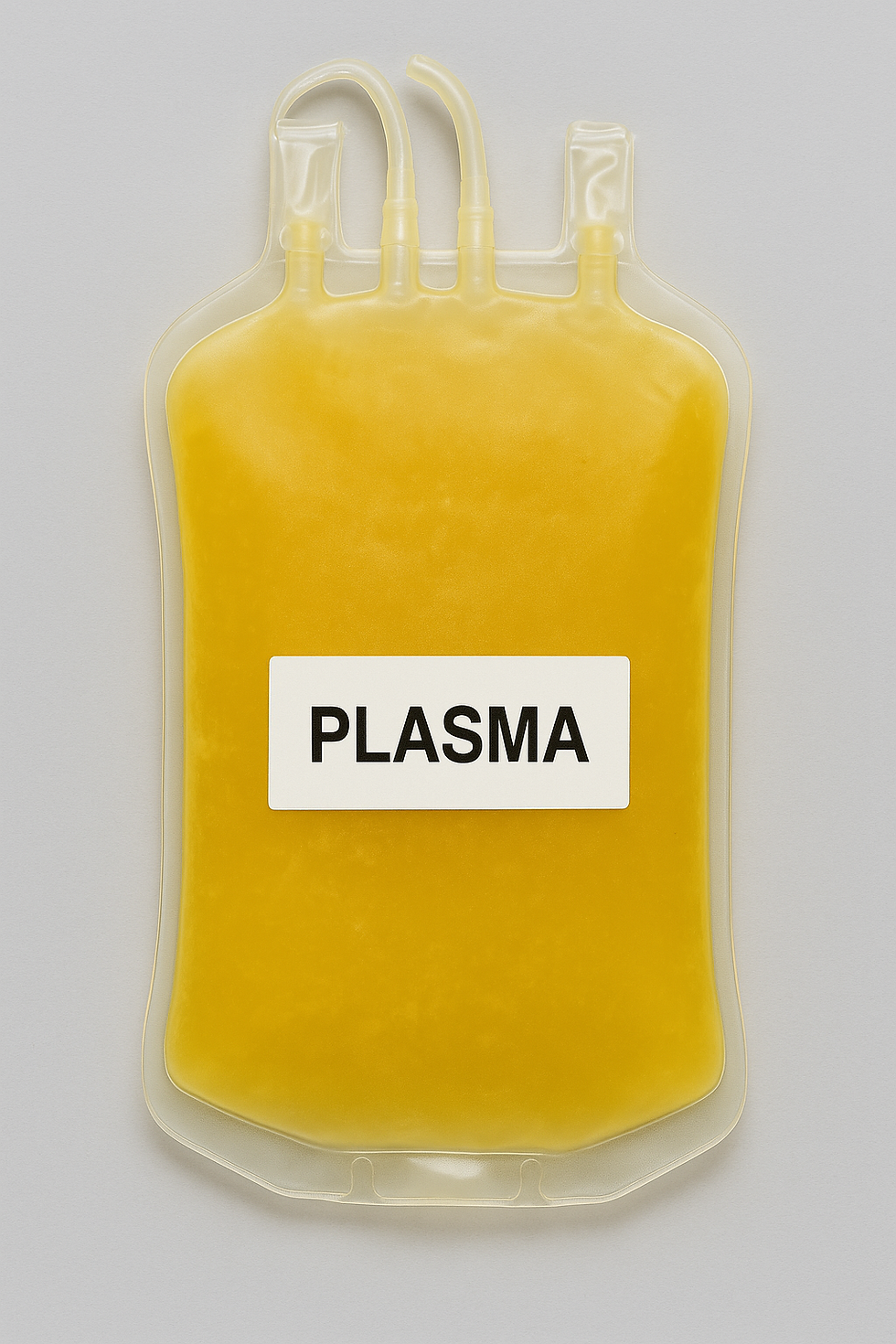Fresh Frozen Facts, Part I: Know Your Plasma
- caitlinraymondmdphd

- Jul 14
- 3 min read

This post kicks off a four-part series on plasma transfusion — starting with the types of plasma products and how they differ. In upcoming posts, we’ll look at common (and not-so-common) indications for plasma, examine where and why plasma is often misused, and explore alternatives to plasma.
When someone says “FFP,” they often mean any kind of plasma product. But not all plasma is created equal — and the distinctions matter. Different processing timelines and storage conditions lead to real differences in coagulation factor content, stability, and shelf life. These variations can impact clinical decisions, especially when patients need rapid hemostasis or factor replacement.
Let’s break it down:
I. Fresh Frozen Plasma (FFP)
FFP is plasma separated and frozen within 8 hours of whole blood collection. It contains the highest levels of labile coagulation factors, especially factor V and factor VIII, which are the most sensitive to degradation during processing and storage.
Storage: Up to 1 year at –18°C or colder.
After thawing: Can be stored at 1–6°C for up to 24 hours and still labeled "FFP." Beyond that, it is relabeled as thawed plasma.
Indications:
Replacement of multiple coagulation factors in active bleeding with documented coagulopathy, especially when specific factor levels are unknown.
Massive transfusion protocols.
Liver disease ONLY IF bleeding is present and the patient has a prolonged PT/aPTT.
DIC, again with bleeding and prolonged PT/aPTT.
Rarer inherited factor deficiencies (e.g., factor V or XI deficiency) when specific concentrates or recombinant factors are unavailable.
Plasma exchange for TTP.
II. Plasma Frozen Within 24 Hours (PF24 or FP24)
PF24 is plasma that is frozen between 8 and 24 hours after collection. It contains slightly lower levels of factor VIII, and potentially modest reductions in other labile factors, but is still considered hemostatically effective in most clinical contexts.
Storage: Up to 1 year at –18°C or colder.
After thawing: Stored at 1–6°C for up to 24 hours as "PF24." After that, it becomes thawed plasma, just like true FFP.
Indications:
Functionally interchangeable with FFP for most transfusion scenarios.
Suitable for warfarin reversal when prothrombin complex concentrate (PCC) is unavailable.
Can be used in TTP or other plasma exchange protocols.
Often preferred for inventory reasons due to longer processing windows and availability.
III. Thawed Plasma
Thawed plasma refers to FFP or PF24 that has been thawed and stored at 1–6°C for more than 24 hours, up to a maximum of 5 days. After the initial 24 hours, it's no longer considered “fresh” due to degradation of labile factors — particularly factors V and VIII.
Factor decline:
Factor VIII can decline by 30–50% within 5 days of refrigerated storage.
Factor V activity typically decreases more slowly but still shows a measurable drop (~20–30%).
Stable factors (e.g., II, VII, IX, X) remain largely intact.
Despite this, thawed plasma retains adequate coagulation activity for most clinical indications.
Indications:
Rapid availability in trauma, massive transfusion, or bleeding scenarios where delay is unacceptable.
Routine plasma transfusions where full labile factor levels are not essential.
Inventory management — hospitals often keep thawed plasma “on the shelf” to reduce wastage and provide faster turnaround.
IV. Cryopoor Plasma (CPP)
Cryopoor plasma is the supernatant remaining after removal of cryoprecipitate from FFP or PF24. It contains significantly reduced levels of:
Fibrinogen
Factor VIII
von Willebrand factor
Factor XIII
But it retains:
Factor V
Factor II, VII, IX, X (the vitamin K–dependent factors)
Indications:
Rarely used, but may be considered in:
TTP, as an exchange fluid when minimizing large multimers of vWF is desirable.
Research protocols or specific institutional use cases.
CPP is not routinely stocked at most hospitals and is unfamiliar to many clinicians.
V. Bottom line:
The plasma product you transfuse might be referred to as “FFP,” but it could be PF24 or thawed plasma. These distinctions aren’t just academic — they can affect hemostatic potential, shelf life, and even clinical utility in certain contexts. When we’re precise about plasma, we reinforce precision in practice — and help ensure the right product reaches the right patient at the right time.
Next up: the historical context of FFP and current good practice for using FFP.






